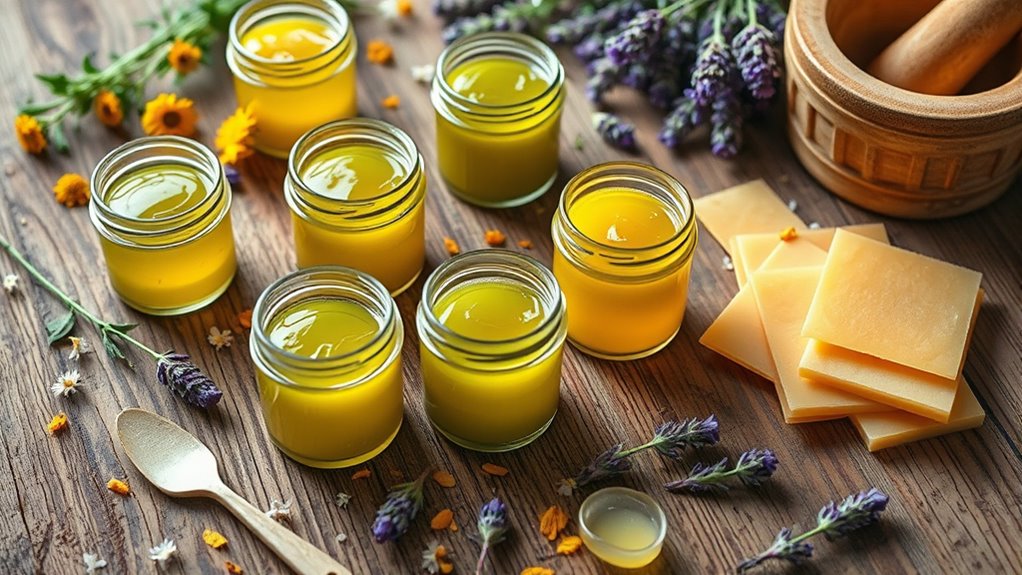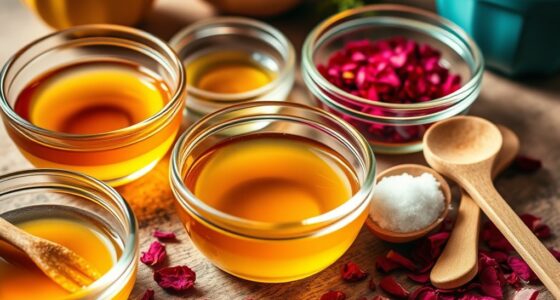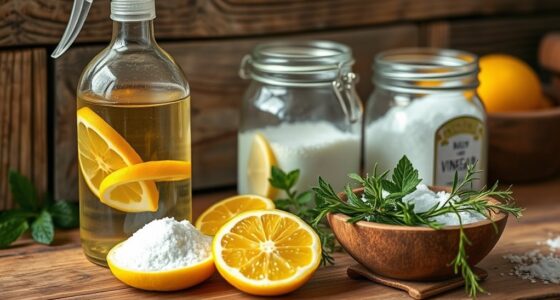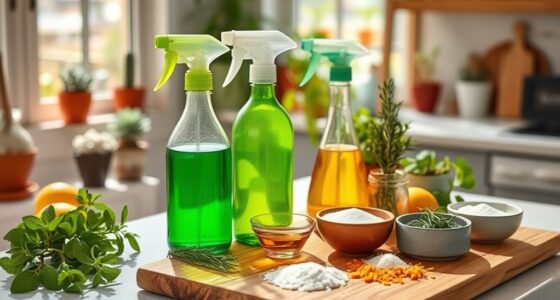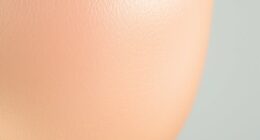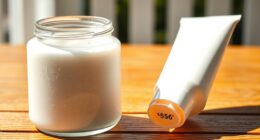To make DIY herbal salves for minor cuts and burns, start by infusing herbs like calendula, comfrey, or plantain into carrier oil through gentle heating or steeping. Strain the herbs, then mix the infused oil with melted beeswax and optional essential oils for added healing. Pour the mixture into clean containers and cool. Keep your salve in a cool, dark spot, and check regularly for freshness. Continue to explore how to create personalized remedies for natural healing.
Key Takeaways
- Infuse herbs like calendula, comfrey, or plantain in carrier oils through gentle heating or steeping.
- Strain the herbal infusion to remove plant matter, creating a clear base for your salve.
- Mix the infusion with melted beeswax and optional essential oils for consistency and added healing properties.
- Store the finished salve in airtight, dark containers to preserve potency and extend shelf life.
- Apply a clean, small amount to minor cuts or burns for natural, effective healing and skin soothing.
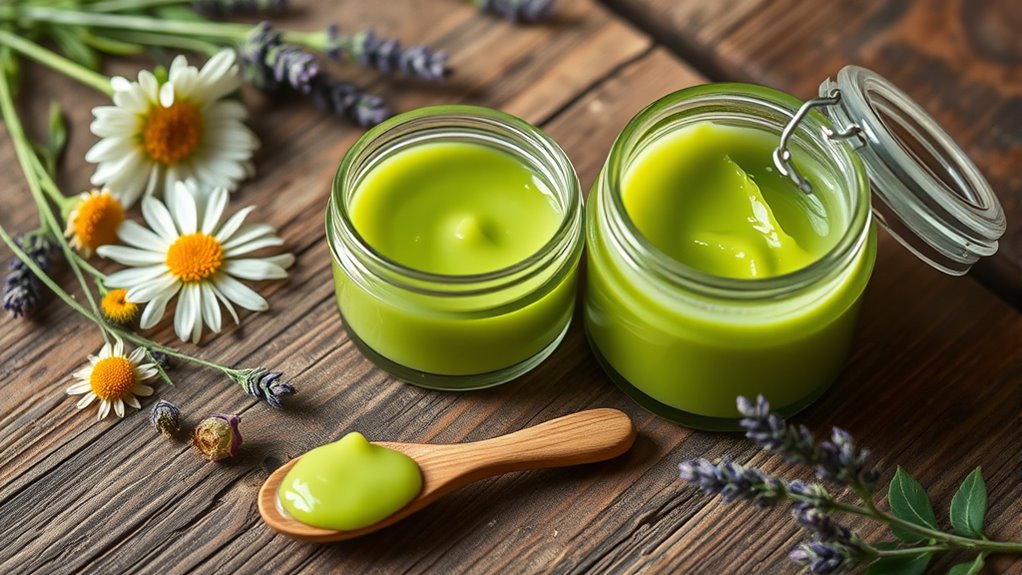
Creating your own herbal salves is a simple and rewarding way to harness nature’s healing powers. When you start making salves at home, you take control of what goes onto your skin, avoiding artificial ingredients and focusing on natural remedies. The process begins with herbal extraction, which is vital for capturing the beneficial compounds from herbs like calendula, comfrey, or plantain. To do this, you’ll need to infuse your herbs into a carrier oil—such as olive or coconut oil—by gently heating or steeping them for several hours or days. This step allows the active constituents to transfer into the oil, creating a potent herbal infusion that forms the base for your salve. Once your herbal extraction is complete, strain out the herbs, guaranteeing your infused oil is clear and free of plant matter. Proper salve storage is essential to maintain its effectiveness and longevity. Keep your finished salve in airtight containers, preferably glass jars, and store them in a cool, dark place to prevent spoilage and preserve the healing properties. Always label your containers with the date and ingredients used, so you know what’s inside and when it was made. Additionally, understanding the importance of herbal extraction techniques ensures you maximize the transfer of beneficial compounds for more effective remedies.
Making herbal salves for minor cuts and burns is straightforward once you’ve mastered herbal extraction and salve storage. After your infusion is ready, you’ll melt a beeswax block or pellets, stirring in the herbal oil until fully combined. The beeswax solidifies as it cools, giving your salve its firm, spreadable consistency. You can add optional ingredients like essential oils for extra healing or fragrance, but keep it simple and safe for sensitive skin. When the salve cools, scoop it into your storage containers and seal them tightly. Remember, proper salve storage not only extends shelf life but also guarantees that the herbal benefits remain potent over time. Regularly check your stored salves for any signs of spoilage, such as changes in smell, color, or texture. Using clean tools when applying your homemade salve prevents contamination, ensuring it stays effective and safe for future use. By mastering these steps, you can confidently create personalized remedies that are both natural and effective.
Frequently Asked Questions
How Long Do Herbal Salves Typically Last?
Herbal salves typically last about 1 to 2 years, depending on shelf life and preservation methods. To extend their longevity, store them in a cool, dark place and use airtight containers. Proper preservation methods, like adding natural antioxidants such as vitamin E, can help prevent spoilage. Always check for changes in smell, color, or texture before use, and discard if you notice any signs of spoilage.
Can Herbal Salves Be Used on Children or Pets?
Herbal salves can be gentle enough for children’s skin and safe for pets if you choose the right ingredients. However, you should always consult a healthcare professional before use because some herbs might cause allergic reactions or aren’t pet-safe. Always prioritize pet safety and consider the age and skin sensitivity of children. When in doubt, test a small patch first to ensure no adverse reactions happen—safety comes first!
Are There Any Herbs to Avoid for Sensitive Skin?
You should avoid herbs that may trigger herb allergy or cause skin sensitivity, especially if you or your child have sensitive skin. Common culprits include comfrey, lavender, and chamomile, which can sometimes cause irritation or allergic reactions. Always do a patch test before applying any herbal salve widely. If you notice redness or discomfort, discontinue use and consult a healthcare professional to prevent adverse reactions.
How Do I Store Herbal Salves Properly?
Think of your herbal salve as a precious gem—handle it with care. Store it in airtight glass or metal containers to protect its potency and prevent spoilage. Keep your salve in a cool, dark place away from direct sunlight and heat, which can shorten its shelf life. Proper storage extends its effectiveness, so check regularly for any changes in smell, color, or texture before use.
Can Herbal Salves Replace Traditional Medical Treatment?
Herbal salves can’t replace traditional medical treatment, especially for serious injuries or infections. While herbal extraction methods and homemade salves can soothe minor cuts and burns, they shouldn’t be your only solution. Store-bought salves often contain preservatives and tested formulations, but homemade options are customizable. Always seek professional medical advice for severe wounds, and use herbal salves as a complementary remedy, not a substitute for proper care.
Conclusion
By making your own herbal salves, you empower yourself to heal, soothe, and care naturally. You save money, reduce chemical exposure, and customize remedies to your needs. You embrace simplicity, creativity, and confidence in your self-care routine. You nurture your skin, support your health, and connect with nature. With each batch you create, you learn, you grow, and you take control. So, get started, experiment often, and enjoy the healing power of your own herbal salves.
